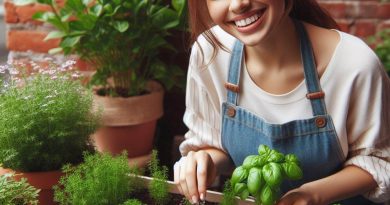Herb Gardening: Flavorful and Easy
Last Updated on February 9, 2024
Introduction
Importance of herbs in cooking
Herbs are culinary essentials, infusing dishes with aromatic flavors, and enhancing gastronomic experiences.
Advantages of herb gardening
- Access to fresh herbs: With an herb garden, you have immediate access to a wide array of fresh herbs, enhancing the taste of your dishes.
- Cost-effective: Growing herbs at home can be significantly cheaper than purchasing them from the store, saving you money in the long run.
- Health benefits: Herbs are packed with essential nutrients, antioxidants, and medicinal properties that promote overall well-being.
By cultivating your herb garden, you not only elevate the taste of your dishes but also reap numerous health benefits.
From basil and parsley to rosemary and thyme, the possibilities are endless.
Whether you have a sprawling backyard or a compact balcony, herb gardening is accessible to all.
Join the journey of cultivating flavorful and aromatic herbs, enriching your culinary adventures and nurturing your health simultaneously.
Getting Started with Herb Gardening
Embarking on a new herb gardening project can be an exciting and rewarding endeavor.
Not only does it add flavor to your meals, but it also provides therapeutic benefits and a chance to connect with nature.
However, before diving into the world of herb gardening, there are a few essential steps you need to take to ensure your success.
Choosing the right location
A crucial first step in herb gardening is choosing the right location for your herbs to thrive.
Sunlight requirements play a vital role in determining which spot in your yard is suitable for your herb garden.
Most herbs prefer full sun, meaning they require at least six hours of direct sunlight each day.
Study the different areas of your yard to identify the spot with the most sun exposure.
Apart from sunlight, soil conditions are another critical factor to consider.
Herbs generally thrive in well-draining soil with a pH level between 6 and 7.
Conduct a soil test to evaluate the pH level and adjust it accordingly.
If your soil is too acidic, add lime, or if it’s too alkaline, incorporate sulfur.
Additionally, ensuring proper drainage is essential to prevent waterlogged soil, which can lead to root rot.
Selecting the appropriate herbs
Once you have determined the ideal gardening location, it’s time to select the appropriate herbs for your garden.
Consider popular culinary herbs like basil, parsley, thyme, and rosemary, which are versatile and commonly used in various dishes.
However, feel free to explore different herbs based on your personal preferences and the flavors you enjoy most.
The beauty of herb gardening lies in the freedom to customize your garden according to your taste and culinary needs.
Gathering necessary supplies
After finalizing your herb selection, gather the necessary supplies to set up your garden.
If you have limited space, opt for pots or containers to grow your herbs.
These provide flexibility as they can be placed in the sunniest spots available.
On the other hand, if space is not an issue, raised garden beds offer an organized and efficient way to grow multiple herbs simultaneously.
To ensure proper growth and development, invest in quality potting soil.
It should be well-draining yet retain moisture to support the herbs’ root systems.
Avoid using regular garden soil, as it can become compacted and hinder the herbs’ growth.
Consider mixing organic matter like compost into the potting soil for added nutrients.
Moreover, proper watering is crucial for herb gardening success.
Depending on the size and location of your garden, you will need watering tools like a watering can or hose to keep your herbs adequately hydrated.
Ensure that your chosen watering method allows for even water distribution while preventing overwatering.
Most herbs prefer slightly moist soil, so monitor their moisture levels regularly.
Therefore, getting started with herb gardening involves choosing the right location, selecting suitable herbs, and gathering necessary supplies.
By considering sunlight requirements and soil conditions, you can create an optimal environment for your herbs to thrive.
Exploring popular culinary herbs and personal preferences adds a customizable touch to your garden.
Finally, investing in pots or raised garden beds, quality potting soil, and proper watering tools helps set the foundation for a successful herb garden.
Now you’re ready to embark on a flavorful herb gardening adventure!
Read: Small-Scale Farming: Profitable Crops Choices
Planting and Caring for Herb Plants
Preparing the soil
Proper soil preparation is crucial for successful herb gardening.
Before planting your herb plants, make sure to amend the soil to provide essential nutrients and improve drainage.
By adding organic matter like compost or well-rotted manure, you can enrich the soil and create a fertile environment for your herbs to thrive.
In addition to soil amendments, it is essential to remove any weeds and rocks from the planting area.
Weeds compete for nutrients and can hinder the growth of your herb plants.
Rocks can impede root development and cause drainage problems.
Clearing the area ensures that your herbs have the best conditions for their growth.
Planting techniques
When starting herb plants from seeds, proper seed sowing techniques are crucial.
Follow the instructions on the seed packets regarding the depth and spacing requirements for the specific herb you are planting.
It is essential to provide adequate sunlight and moisture for the seeds to germinate and sprout.
Transplanting seedlings is another planting technique you can employ.
Once your seedlings have grown enough, carefully remove them from their nursery pots and transplant them into the prepared soil.
Be gentle with the roots, ensuring they are well-established in the soil and water them immediately after transplanting.
Watering and fertilizing
Watering herb plants is critical for their health and growth.
Depending on the type of herb and the climate conditions, the watering frequency may vary.
Generally, herbs require moderate watering, ensuring that the soil is evenly moist but not waterlogged.
Over-watering can lead to root rot, so it is essential to strike a balance.
When fertilizing your herb plants, opt for organic fertilizers.
These fertilizers are safer for both the plants and the environment, as they do not contain harmful chemicals.
Organic options include compost, worm castings, or liquid seaweed extract.
Regularly fertilizing your herbs will provide them with the necessary nutrients for healthy growth and flavor development.
Pest and disease control
Pests and diseases can pose a threat to your herb garden, but there are ways to control them naturally.
Some common pests that affect herbs include aphids, slugs, and snails.
Encourage natural predators like ladybugs or lacewings, or use physical barriers like mesh nets to protect your plants.
If infestations occur, homemade sprays with ingredients like garlic or neem oil can help combat the pests.
Most importantly, properly caring for your herb plants involves various steps, from soil preparation to pest control.
By amending the soil, removing weeds and rocks, employing proper planting techniques, and providing adequate watering and fertilization, you can enjoy a flourishing herb garden.
With natural pest and disease control methods, you can enhance the health and vitality of your herbs while ensuring enjoyable and flavorful harvests.
Read: Urban Beekeeping: Boost Your Garden’s Yield

Harvesting and Preserving Herbs
Appropriate time for harvesting
Harvesting and preserving herbs is an essential part of herb gardening.
Knowing when to harvest and how to store your herbs will ensure that you have a fresh and flavorful supply all year round.
When it comes to leafy herbs, such as basil, parsley, and cilantro, the best time to harvest them is when they are at their peak flavor and just before they start to flower.
This is usually when the leaves are lush and vibrant.
Flowering herbs, on the other hand, should be harvested when the flowers are fully open. This is when they are at their most fragrant.
Harvesting techniques
There are two main techniques for harvesting herbs – pinching and cutting stalks.
Pinching involves removing the leaves or stems just above a leaf node.
This not only encourages the plant to branch out and produce more foliage but also helps maintain the plant’s shape.
Cutting the stalks, on the other hand, is used for herbs like rosemary and thyme.
Using clean and sharp pruners, you can cut the entire stalk just above the base.
Methods of preserving herbs
Preserving herbs is important to extend their shelf life and make the most out of your harvest.
The three main methods of preserving herbs are drying, freezing, and making herb-infused oils.
Drying is the easiest method and works well for herbs with low moisture content like thyme and oregano.
Simply tie small bundles of herbs together and hang them upside down in a dry, well-ventilated area.
Once the herbs are completely dry and brittle, you can remove the leaves from the stems and store them in airtight containers.
Freezing is another great way to preserve herbs, especially if you want to retain their fresh flavor and vibrant color.
Some herbs can be frozen whole, like basil leaves, while others can be chopped and stored in freezer bags or airtight containers.
Herb-infused oils are a fantastic way to add flavor to your dishes.
Simply place fresh herbs, like rosemary or thyme, in a jar, cover with oil, and let it sit for a few weeks.
The oil will take on the flavors of the herbs, creating a delicious infusion.
In essence, harvesting and preserving herbs doesn’t have to be a complicated process.
By knowing the appropriate time to harvest your herbs and using the right techniques for preservation, you can enjoy the flavors and benefits of your herb garden all year round.
Read: Crop Rotation: Secrets for Small-Scale Farms
Cooking with Fresh Herbs
Cooking with fresh herbs can take your dishes from ordinary to extraordinary.
Not only do herbs add flavor, but they also bring a freshness that elevates the overall taste.
Here are some ways you can enhance the flavors in your different dishes using fresh herbs.
Enhancing flavors in different dishes
Salads and dressings
When making salads, don’t limit yourself to just lettuce and basic toppings.
Adding fresh herbs like cilantro, basil, or dill can give your salad a burst of flavor.
You can also make homemade dressings using herbs like parsley or mint to create unique and refreshing flavors.
Marinades and sauces
Infusing your marinades and sauces with fresh herbs can make a world of difference in taste.
Whether you’re grilling chicken or preparing a pasta sauce, adding herbs like rosemary, thyme, or oregano can add depth and complexity to your dishes.
Soups and stews
Herbs are essential for enhancing the flavors of soups and stews.
By adding herbs like bay leaves, sage, or tarragon to your simmering pot, you can create rich and aromatic broths that will make your soups and stews truly delicious.
Tips for using fresh herbs
Proper handling and chopping
To maximize the flavor of your herbs, it’s important to handle and chop them correctly.
First, make sure to wash your herbs thoroughly and dry them properly.
When chopping, use a sharp knife to avoid bruising the leaves, and always chop them just before adding to your dish to preserve their freshness.
Mixing different herbs
Experimenting with different herb combinations can take your dishes to the next level.
Try mixing herbs that complement each other, such as rosemary and thyme or basil and parsley.
Just remember to use herbs in moderation, as they can quickly overpower other flavors if used in excess.
In fact, cooking with fresh herbs is a fantastic way to enhance the flavors of your dishes.
Whether you’re making salads, marinades, soups, or stews, adding herbs can bring a unique and delicious twist to your culinary creations.
By following these tips for handling and chopping herbs and exploring different herb combinations, you’re sure to elevate your cooking to new heights.
Enjoy the flavorful journey of herb gardening in your kitchen!
Read: Eco-Friendly Pest Control in Gardens
Conclusion
The joy of herb gardening
Delight in the rewarding experience of nurturing and harvesting an array of flavorful herbs at home.
- Witness the growth and vibrancy of aromatic foliage.
- Revel in the sensory pleasure of touching, smelling, and tasting freshly picked herbs.
Integration of herbs in everyday cooking
Elevate your culinary creations by seamlessly incorporating homegrown herbs into your daily dishes.
- Infuse soups, salads, and sauces with the distinctive flavors of basil, cilantro, or mint.
- Experiment with herb-infused oils, vinegars, and butters to add depth and complexity to your cooking.
Encouraging others to start their own herb gardens
Spread the joy of herb gardening and inspire others to embark on their flavorful journey.
- Share your experiences, tips, and successes with friends, family, and neighbors.
- Encourage everyone to cultivate their herbs, enriching their meals and fostering a deeper connection with nature.
Together, let’s sow the seeds of herb gardening passion and harvest the abundant rewards of flavorful, homegrown goodness.


